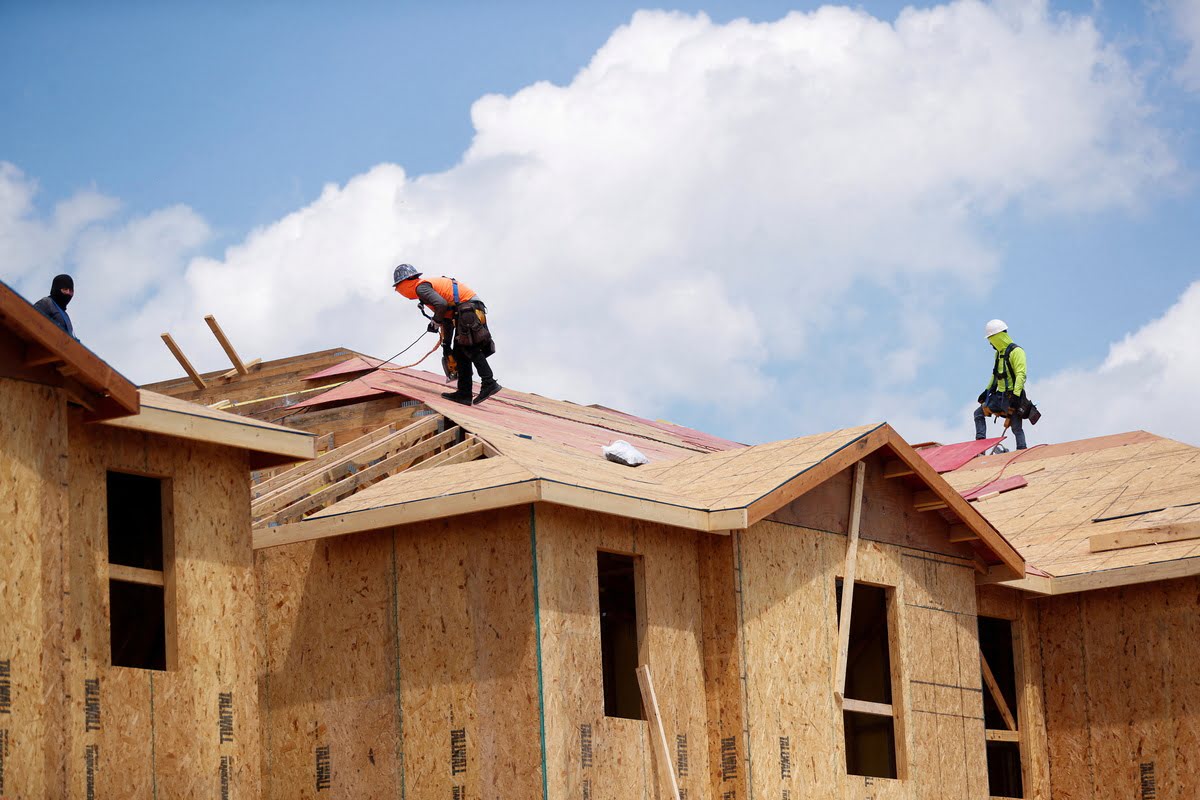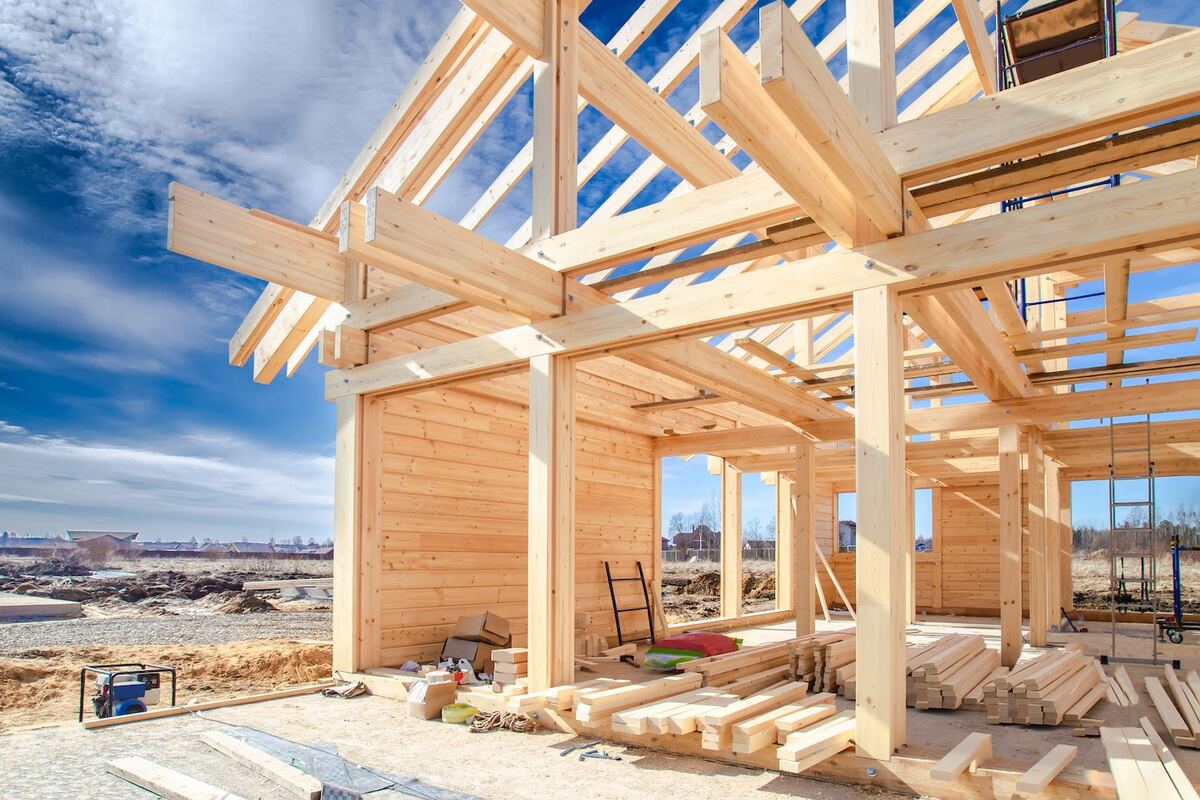Home>diy>Building & Construction>When Will Home Construction Prices Go Down


Building & Construction
When Will Home Construction Prices Go Down
Modified: January 9, 2024
Find out when home construction prices will go down and how it can impact the building construction industry. Stay informed and plan your projects accordingly.
(Many of the links in this article redirect to a specific reviewed product. Your purchase of these products through affiliate links helps to generate commission for Storables.com, at no extra cost. Learn more)
Introduction
Welcome to the world of construction, where dreams become reality and buildings rise from the ground. Home construction is an essential part of our lives, as it not only provides shelter but also shapes our communities. However, one aspect that can make or break the decision to build a home is the price. Home construction prices have a significant impact on homeowners’ budgets and can determine whether a dream home becomes a reality or remains a distant aspiration.
In this article, we will explore the factors that affect home construction prices and analyze the current trends in the industry. We will delve into the impact of material and labor shortages, government policies and regulations, market demand, and economic conditions. Additionally, we will discuss how these factors forecast future home construction prices.
Understanding the dynamics of home construction pricing is crucial for prospective homeowners, real estate developers, and contractors alike. By gaining insight into the driving forces behind pricing fluctuations, we can make informed decisions about when to initiate a construction project and anticipate potential cost savings.
So, let’s dive into the fascinating world of home construction and uncover the factors that contribute to the rise and fall of construction prices. Whether you are planning to build your dream home, looking to invest in real estate, or simply curious about the dynamics of the industry, this article will provide valuable insights into the realm of home construction pricing.
Key Takeaways:
- Material and labor shortages, government regulations, market demand, and economic conditions all play pivotal roles in influencing home construction prices. Understanding these factors is crucial for making informed decisions and managing costs effectively.
- Forecasting future home construction prices is a complex task that requires analyzing market trends, economic indicators, and external influences. While challenging, staying informed and seeking expert opinions can help stakeholders make more informed decisions.
Read more: How To Price A Job In Construction
Factors Affecting Home Construction Prices
Home construction prices are influenced by a multitude of factors that contribute to the overall cost of the project. Understanding these factors can help homeowners, developers, and contractors navigate the complexities of pricing and make informed decisions. Let’s explore some of the key factors that impact home construction prices:
- Location: The geographical location of a construction project plays a significant role in determining the cost. Construction costs can vary significantly between urban and rural areas, and even within different neighborhoods of the same city. Factors such as land value, availability of skilled labor, transportation costs, and local building regulations can all contribute to price fluctuations.
- Architectural Design: The complexity and uniqueness of the architectural design can impact construction prices. Intricate designs with unconventional shapes or challenging building techniques often require specialized labor and materials, driving up the cost. Simple, straightforward designs, on the other hand, are generally more cost-effective.
- Materials: The cost of construction materials, such as concrete, steel, wood, and electrical components, can significantly impact the overall price. Market conditions, including supply and demand and fluctuations in raw material costs, can lead to price volatility. Additionally, the choice of materials can also affect pricing. High-end materials tend to be more expensive than standard or budget-friendly alternatives.
- Labor: Skilled labor is a critical component of home construction, and the availability and cost of labor can impact pricing. Shortages of skilled tradespeople can drive up wages, while oversupply can lower labor costs. Factors such as the construction industry’s local labor market, labor union regulations, and the complexity of the project can all affect labor prices.
- Permits and Regulations: Government permits, inspections, and regulations can add time and expenses to a construction project. The cost of obtaining permits, complying with building codes, and meeting safety standards can vary significantly between municipalities. Understanding and navigating these requirements is essential for controlling costs.
These are just some of the key factors that can influence home construction prices. It is crucial to consider these factors and evaluate their impact when budgeting for a construction project. By understanding the interplay between location, design, materials, labor, and regulations, homeowners, developers, and contractors can better anticipate and manage construction costs.
Current Trends in Home Construction Costs
Home construction costs are influenced by numerous factors that can fluctuate over time. Understanding the current trends in home construction costs can provide valuable insights for homeowners, builders, and investors. Let’s take a closer look at some of the prevailing trends in the industry:
- Rising Material Costs: In recent years, the construction industry has experienced significant fluctuations in the cost of building materials. Factors such as increased demand, tariffs on imported materials, and supply chain disruptions have contributed to rising material costs. Lumber, in particular, has seen dramatic price increases, causing construction expenses to soar. To mitigate these price hikes, many builders are exploring alternative construction methods and materials.
- Labor Shortages: The construction industry is currently facing a shortage of skilled labor. As experienced tradespeople retire and fewer young workers enter the industry, finding skilled workers has become increasingly challenging. The labor shortage has led to increased wages for construction workers, driving up labor costs for home construction projects. To overcome this challenge, some contractors are turning to technology and automation to streamline processes and reduce reliance on manual labor.
- Sustainable Construction Practices: With a growing emphasis on sustainability and environmental consciousness, many home construction projects are incorporating green building practices. This includes the use of energy-efficient materials, renewable energy systems, and eco-friendly design principles. While sustainable construction practices can lead to higher upfront costs, they often result in long-term cost savings through reduced energy consumption and lower maintenance expenses.
- Technological Advancements: Technology is transforming the construction industry in various ways. From Building Information Modeling (BIM) software to drones and robotics, these advancements offer opportunities to optimize efficiency, improve accuracy, and reduce construction costs. For example, BIM allows for better project planning and coordination, reducing errors and rework. Additionally, automated construction processes can help compensate for labor shortages and enhance overall productivity.
- Supply Chain Disruptions: The COVID-19 pandemic has had a profound impact on global supply chains, affecting the availability and pricing of construction materials. Shipping delays, factory closures, and increased demand for home improvement projects have created challenges in sourcing materials, leading to potential price increases and project delays. It is essential for builders and homeowners to stay updated on supply chain disruptions and develop contingency plans to minimize their impact.
Keeping abreast of these current trends in home construction costs is crucial for anyone involved in the industry. By understanding the factors driving material costs, labor shortages, sustainable practices, technological advancements, and supply chain disruptions, stakeholders can adapt their strategies and make informed decisions to manage construction costs effectively.
Impact of Material and Labor Shortages on Home Construction Prices
Material and labor shortages have a significant impact on home construction prices, contributing to increased costs and project delays. These shortages can be influenced by various factors and have ripple effects throughout the construction industry. Let’s delve into how material and labor shortages affect home construction prices:
Material Shortages:
Material shortages can occur due to a variety of factors, including increased demand, supply chain disruptions, and trade policies. When there is a scarcity of construction materials, the cost of those materials tends to rise. This is due to the basic principles of supply and demand, as the limited availability drives up prices.
The most notable example in recent history is the increase in lumber prices. The COVID-19 pandemic, coupled with trade disputes and wildfires, caused a surge in demand for lumber and reduced production. As a result, lumber prices skyrocketed, significantly impacting the overall cost of home construction.
Other materials, such as steel, concrete, and electrical components, can also experience shortages and price spikes. Fluctuations in the cost of materials have a direct impact on construction budgets, as builders and homeowners must adjust their plans to accommodate the increased expenses.
Labor Shortages:
The construction industry is grappling with a shortage of skilled labor, which has been a persistent issue in recent years. As experienced tradespeople retire, there are fewer young workers entering the industry to fill the gap. This scarcity of skilled labor leads to increased competition for workers, resulting in higher wages to attract and retain talent.
Higher labor costs, in turn, increase home construction prices. Contractors and builders have to factor in these higher wages while estimating project budgets, leading to an overall increase in construction costs. Additionally, labor shortages can also lead to project delays as there are not enough workers available to complete the work on schedule.
Working Through the Challenges:
To mitigate the impact of material and labor shortages on home construction prices, builders and homeowners can employ various strategies. Here are some approaches that can help navigate these challenges:
- Alternative Materials: Exploring alternative construction materials that are readily available and cost-effective can help reduce reliance on materials experiencing severe shortages and price increases.
- Technology and Prefabrication: Embracing technology and prefabrication methods can speed up construction timelines and reduce reliance on manual labor, mitigating the impact of labor shortages.
- Supply Chain Management: Developing strong relationships with suppliers and closely monitoring the supply chain can help anticipate and address material shortages. Engaging multiple suppliers or securing materials in advance can mitigate potential delays and price fluctuations.
- Efficient Project Management: Streamlining processes and optimizing project management can help reduce labor costs and increase productivity, allowing projects to be completed more efficiently, even with a limited workforce.
Overall, material and labor shortages have a significant impact on home construction prices. Understanding the underlying causes and implementing strategies to navigate these challenges can help builders, contractors, and homeowners effectively manage costs and ensure the successful completion of construction projects.
Government Policies and Regulations on Home Construction Costs
Government policies and regulations play a vital role in shaping home construction costs. These policies are designed to ensure safety, standardization, and adherence to building codes. However, they can also impact the financial aspects of construction projects. Let’s explore how government policies and regulations influence home construction costs:
Building Codes and Standards:
Government regulations establish building codes and standards that dictate the minimum requirements for construction projects. These codes cover aspects such as structural integrity, fire safety, accessibility, electrical and plumbing systems, and energy efficiency. While these regulations are essential for ensuring the safety and quality of homes, they can also increase construction costs.
Complying with building codes often involves additional materials, labor, and design modifications, which can add expenses to a construction project. Builders and homeowners must allocate resources to meet these regulatory requirements, ultimately affecting the overall cost of home construction.
Permits and Inspections:
Obtaining permits and undergoing inspections is a necessary part of the construction process. Governments require permits to ensure that constructions projects adhere to zoning regulations, environmental standards, and building codes. Inspections are conducted at various stages to verify compliance and identify any potential issues that need to be addressed.
However, the process of acquiring permits and scheduling inspections can introduce delays and increase costs. Permit fees, associated paperwork, and waiting times can impact construction budgets and timelines. It is essential for builders and homeowners to factor in these additional expenses and account for potential delays when planning a construction project.
Environmental and Energy Regulations:
Government regulations related to environmental and energy efficiency standards can also influence home construction costs. Increasingly, governments are implementing regulations aimed at reducing the environmental impact of buildings and promoting energy-efficient practices.
These regulations may require the use of specific materials, such as low VOC (volatile organic compound) paints or energy-efficient insulation. While these materials are beneficial in the long run due to reduced energy consumption and operational costs, they may initially have higher upfront costs, impacting the overall construction budget.
Subsidies and Incentives:
On the other hand, governments also provide subsidies and incentives that can help mitigate some construction costs. These incentives may include tax credits, grants, or subsidies for energy-efficient or sustainable building practices. By taking advantage of these programs, builders and homeowners can offset some of the additional expenses incurred due to government regulations.
It is important for individuals in the construction industry to stay updated on government policies and regulations that affect home construction costs. This knowledge allows them to accurately assess the financial implications of regulatory compliance and take advantage of available subsidies and incentives. By understanding and proactively adapting to government policies, builders and homeowners can effectively manage home construction costs and ensure compliance with all necessary regulations.
Keep an eye on lumber prices, as they have a significant impact on home construction costs. When lumber prices decrease, it’s likely that home construction prices will follow suit.
Read more: When Does Target Home Decor Go On Sale
The Role of Market Demand in Home Construction Pricing
Market demand is a significant driving force behind home construction pricing. Understanding the dynamics of market demand is essential for builders, developers, and homeowners, as it directly affects the cost of construction projects. Let’s explore the role of market demand in home construction pricing:
Supply and Demand Balance:
Market demand for housing is a reflection of the number of potential buyers or renters seeking homes in a specific area. When demand exceeds supply, it creates a seller’s market, where prices tend to rise. Conversely, when supply exceeds demand, it creates a buyer’s market, leading to potential price reductions or incentives to attract buyers.
In the context of home construction, market demand influences the price of new construction projects. If there is high demand for homes in a particular area, builders may be able to command higher prices for their properties. On the other hand, if demand is low, builders may need to adjust their pricing strategy to attract buyers.
Location and Desirability:
The location and desirability of a construction project significantly impact market demand and, in turn, home construction pricing. Areas with strong economic growth, employment opportunities, good schools, amenities, and access to transportation tend to attract higher demand for housing.
In these desirable locations, builders may be able to charge a premium for newly constructed homes. The demand for homes in prime areas often exceeds the supply, leading to increased competition among buyers and potentially higher prices.
Consumer Preferences and Trends:
Consumer preferences and trends also play a crucial role in market demand for home construction. For example, there may be a growing demand for energy-efficient homes, smart technology integration, or sustainable building practices. Builders who cater to these preferences can leverage market demand to command higher prices for their homes.
Similarly, shifts in lifestyle preferences, such as increased demand for open floor plans or home office spaces, can influence market demand and pricing. Builders who anticipate and incorporate these trends into their construction projects can position themselves to meet market demand and potentially command higher prices.
Competition and Pricing Strategy:
The level of competition within the home construction market also affects pricing. When there are numerous builders and developers vying for buyers in a particular area, competition can drive pricing pressure. Builders may need to adjust their pricing strategy to remain competitive and attract buyers.
Conversely, if a builder has a unique selling proposition, such as innovative design, superior craftsmanship, or exclusive amenities, they may be able to set higher prices for their homes due to limited direct competition in the market.
Market Outlook and Economic Conditions:
The overall economic conditions, including interest rates, employment rates, and consumer confidence, also influence market demand for new construction homes. During periods of economic growth and stability, demand for homes tends to be higher, supporting higher home construction prices.
On the other hand, during economic downturns or periods of instability, demand may decrease, leading to lower pricing or the need for builders to adjust their pricing strategy to remain competitive.
Understanding and analyzing market demand is crucial when planning a home construction project. By staying informed about local market trends, consumer preferences, competition, and economic conditions, builders and developers can effectively position themselves to meet market demand and set appropriate pricing for their construction projects.
Economic Conditions and Home Construction Prices
Economic conditions have a significant impact on home construction prices. The state of the economy, including factors such as interest rates, inflation, employment rates, and consumer confidence, can influence the cost of construction projects. Let’s explore how economic conditions affect home construction prices:
Interest Rates:
Interest rates play a critical role in determining the affordability of homes. When interest rates are low, borrowing costs decrease, making it more attractive for potential homeowners to finance a new construction project. This increased demand can lead to higher home prices as buyers are willing to pay more for homes they can afford with lower monthly mortgage payments.
Conversely, when interest rates are high, borrowing costs increase. This can dampen demand for new construction homes as potential buyers may be deterred by the higher cost of financing. When demand decreases, builders may need to adjust their prices to attract buyers, potentially leading to lower home construction prices.
Inflation and Material Costs:
Inflation is the rise in the overall prices of goods and services over time. When inflation occurs, it can influence the cost of construction materials. As the prices of raw materials, such as lumber, steel, and concrete, increase, builders and developers may face higher construction costs. These increased material costs can impact the pricing of new construction homes to maintain profitability.
Inflation also affects labor costs. With inflation, wages may increase as workers demand higher compensation to keep up with the rising cost of living. This can contribute to higher labor costs for construction projects, leading to higher home construction prices.
Employment Rates:
The employment rate in an economy has a direct correlation with the housing market. When employment rates are high and incomes are stable, individuals and families are more likely to have the financial means to purchase a new construction home. This increased demand can drive up home prices as buyers compete for limited inventory.
Conversely, when employment rates are low and there is uncertainty in the job market, potential buyers may hesitate to invest in a new construction project. This decrease in demand can lead to lower home construction prices as builders adjust their pricing strategy to attract buyers.
Consumer Confidence:
Consumer confidence is a measure of individuals’ perception of the current and future state of the economy. When consumer confidence is high, individuals are more likely to make major purchases, such as buying a new construction home. This increased demand can drive up home prices as buyers are willing to pay a premium for the perceived value.
On the other hand, when consumer confidence is low, individuals may be hesitant to make significant financial commitments. This can lead to decreased demand for new construction homes, prompting builders to adjust their pricing strategy to attract buyers in a more cautious or uncertain market.
Economic conditions are a significant factor in determining home construction prices. Builders, developers, and potential homeowners need to monitor the state of the economy, including interest rates, inflation, employment rates, and consumer confidence, to make informed decisions regarding pricing and affordability. Understanding the relationship between economic conditions and home construction prices is crucial for navigating the ever-changing housing market.
Forecasting Future Home Construction Prices
Forecasting future home construction prices is a complex task that requires an understanding of various factors, including market trends, economic indicators, and external influences. While it is impossible to predict future prices with absolute certainty, there are several methods and considerations that can provide insight into potential price movements. Let’s explore some of the approaches to forecasting future home construction prices:
Market Analysis:
Market analysis involves assessing current market conditions and trends to project future pricing. By examining factors such as supply and demand dynamics, population growth, job market trends, and migration patterns, analysts can gain insight into the future direction of home prices. The analysis may involve studying historical data, conducting surveys, and monitoring real estate market indicators to identify potential price trends.
Economic Indicators:
Economic indicators play a crucial role in forecasting future home construction prices. Factors such as interest rates, inflation, employment rates, and consumer confidence can provide valuable insights into the overall health of the economy and its impact on housing. Analysing these indicators and their potential future trends can help predict how changes in the economy may affect demand, lending conditions, and construction costs, influencing future home construction prices.
Construction Costs:
Monitoring construction costs is an important aspect of forecasting future home construction prices. Fluctuations in the prices of construction materials, labor rates, and other related expenses can impact the overall cost of construction projects. Keeping tabs on these costs and understanding their historical patterns and potential future trends can help provide a basis for estimating future home construction prices.
Housing Market Dynamics:
Analysing housing market dynamics, such as inventory levels, sales trends, and price growth, can provide insights into future home construction prices. For example, if there is an increase in demand for homes but limited supply, it may lead to higher prices and provide an indication that there could be a market for new construction projects at higher price points. Conversely, if there is an oversupply of homes, it may signal potential downward pressure on prices and caution in initiating new construction projects.
External Influences:
Considering external influences is important when forecasting future home construction prices. Factors such as government policies, zoning regulations, interest rate changes, and geopolitical events can have a significant impact on the housing market. Assessing these factors and their potential implications on housing demand and construction costs can help forecast future pricing trends.
Expert Opinions:
Seeking the expertise of real estate professionals, economists, and industry analysts can provide valuable insights and opinions on future home construction prices. These experts often have access to in-depth research, market data, and industry knowledge, which they can leverage to make informed predictions about future pricing trends.
It is important to note that forecasting future home construction prices is inherently challenging, as it involves various factors and uncertainties. While these approaches provide a foundation for analysis, it is crucial to exercise caution and consider multiple perspectives when making decisions based on price forecasts. Additionally, relying on up-to-date market research, staying informed about industry trends, and regularly reassessing forecasts can help adapt strategies based on evolving market conditions.
By combining these approaches and closely monitoring market conditions, economic indicators, construction costs, housing market dynamics, and external influences, stakeholders in the home construction industry can formulate more informed projections about future home construction prices.
Conclusion
Home construction prices are influenced by a multitude of factors that interact and fluctuate over time. Understanding these factors is crucial for homeowners, developers, and contractors as they navigate the complexities of pricing and make informed decisions about construction projects. Throughout this article, we have explored the various factors that affect home construction prices, current trends in the industry, and the impact of material and labor shortages, government policies, market demand, economic conditions, and forecasting future prices.
Material and labor shortages have been a prominent issue in recent years, driving up construction costs due to limited availability and increased competition for resources. Builders and homeowners must find ways to mitigate these challenges through alternative materials, technological advancements, and efficient project management to maintain cost-effective construction practices.
Government policies and regulations are another significant factor affecting home construction prices. While these regulations are crucial for ensuring safety and quality, they can add expenses and complexity to construction projects. Staying informed about building codes, permits, and environmental standards is essential for managing costs and ensuring compliance with regulations.
Market demand, driven by factors such as location, consumer preferences, and economic conditions, plays a vital role in home construction pricing. Understanding the dynamics of supply and demand, as well as the impact of market trends and economic indicators, can help builders and developers set appropriate pricing strategies and anticipate potential changes in the market.
Forecasting future home construction prices is no easy feat, as it requires a thorough analysis of various factors, including market trends, economic indicators, construction costs, housing market dynamics, and external influences. While it is impossible to predict prices with certainty, by considering these factors and seeking expert opinions, stakeholders can make more informed decisions and adapt strategies as market conditions evolve.
In conclusion, the world of home construction pricing is complex, influenced by a myriad of factors, from material and labor shortages to government regulations, market demand, and economic conditions. By staying informed, utilizing innovative practices, and understanding the interplay between these factors, stakeholders can navigate the challenges and make sound decisions to ensure successful and cost-effective home construction projects.
Frequently Asked Questions about When Will Home Construction Prices Go Down
Was this page helpful?
At Storables.com, we guarantee accurate and reliable information. Our content, validated by Expert Board Contributors, is crafted following stringent Editorial Policies. We're committed to providing you with well-researched, expert-backed insights for all your informational needs.















0 thoughts on “When Will Home Construction Prices Go Down”